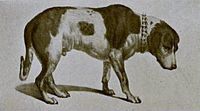Barry (dog)

A drawing of Barry, preserved at the Natural History Museum of Bern prior to the modifications conducted in 1923.
|
|
| Other name(s) | The Saint of Saints |
|---|---|
| Species | Dog |
| Breed | Referred to as a Küherhund or Alpine Mastiff; later as a St. Bernard |
| Sex | Male |
| Born |
Barry der Menschenretter 1800 Great St Bernard Hospice, Pennine Alps |
| Died | 1814 Bern, Switzerland |
| Nation from | Swiss |
| Occupation | Search and rescue dog |
| Employer | Great St Bernard Hospice |
| Years active | 1800–1812 |
| Weight | 40–45 kilograms (88–99 lb) |
| Height | Less than 64 centimetres (25 in) |
Barry der Menschenretter (1800–1814), also known as Barry, was a dog of a breed which was later called the St. Bernard that worked as a mountain rescue dog in Switzerland for the Great St Bernard Hospice. He predates the modern St. Bernard, and was lighter built than the modern breed. He has been described as the most famous St. Bernard, as he was credited with saving more than 40 lives during his lifetime, hence his byname "Menschenretter" meaning people rescuer in German.
The legend surrounding him was that he was killed while attempting a rescue; however, this is untrue. Barry retired to Bern, Switzerland and after his death his body was passed into the care of the Natural History Museum of Bern. His skin has been preserved through taxidermy although his skull was modified in 1923 to match the Saint Bernard of that time period. His story and name have been used in literary works, and a monument to him stands in the Cimetière des Chiens near Paris. At the hospice one dog has always been named Barry in his honor and since 2004 the Foundation Barry du Grand Saint Bernard has been set up to take over the responsibility for breeding dogs from the hospice.
The first mention in the Great St Bernard Hospice archives of a dog was in 1707 which simply said "A dog was buried by us." The dogs are thought to have been introduced to the monastery as watchdogs at some point between 1660 and 1670. Old skulls from the collection of the Natural History Museum of Bern show that at least two types of dog lived at the hospice. By 1800, the year that Barry was born, it was known that a special kind of dog was being used for rescue work in the pass. This general variety of dog was known as a Küherhund, or cowherd's dog.
Measurements of his preserved body show that Barry was smaller than the modern Saint Bernard, weighing between 40 and 45 kilograms (88 and 99 lb) whereas modern Bernards weigh between 80 and 130 kilograms (180 and 290 lb). His current mounted height is approximately 64 centimetres (25 in), but the living Barry would have been slightly smaller.
During Barry's career, he was credited with saving the lives of more than forty people, although this number has sometimes varied over the years. Barry's most famous rescue was that of a young boy. He found the child asleep in a cavern of ice. After warming up the boy's body sufficiently by licking him, he moved the boy about and onto his back and carried the child back to the hospice. The child survived and was returned to his parents, although other sources say that the boy's mother died in the avalanche that trapped the boy. The Museum of Natural History in Bern disputes the legend, attributing it to Peter Scheitlin, an animal psychologist.
...
Wikipedia
